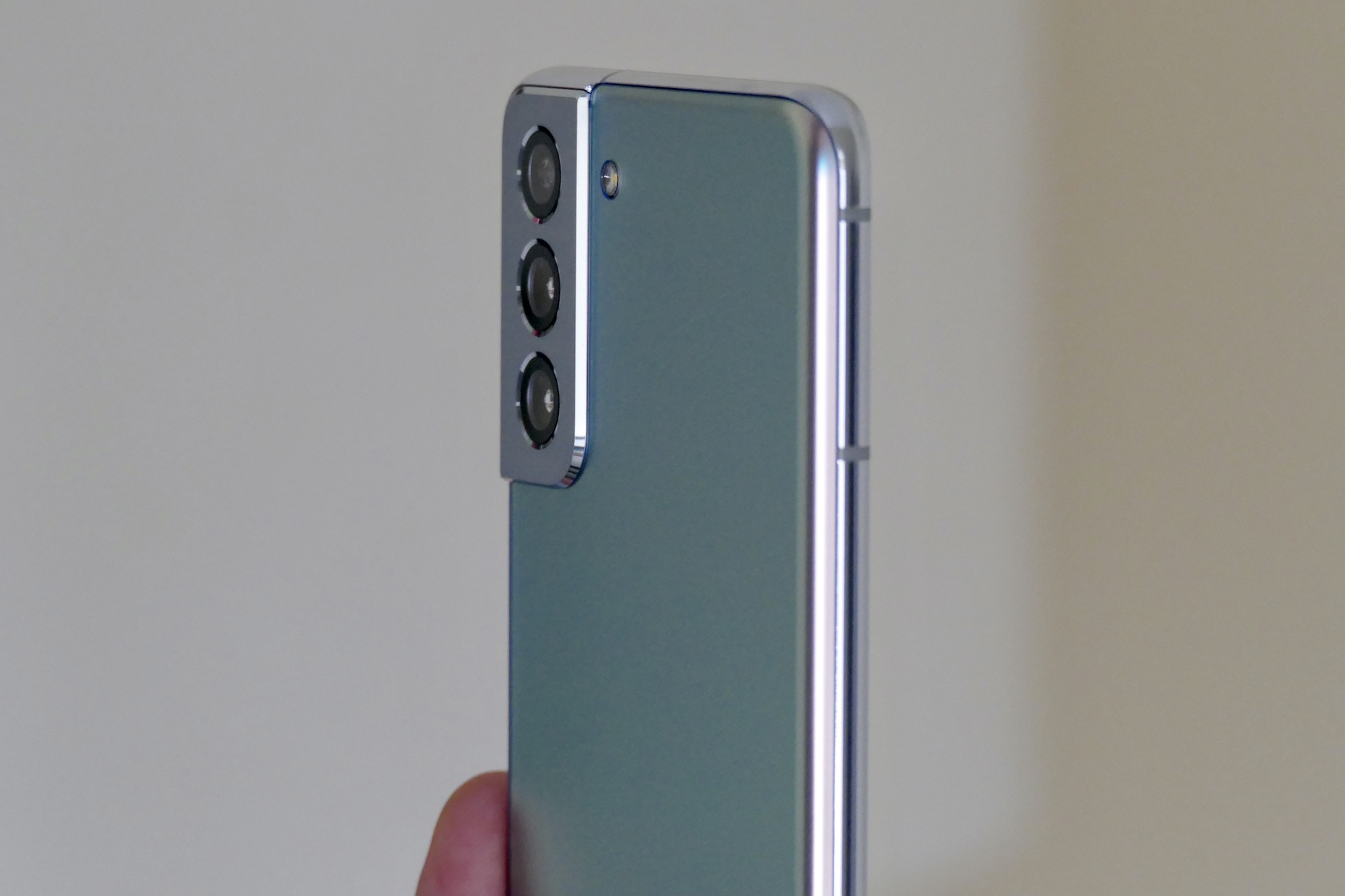“The Galaxy S21+ 5G is a classier, bigger version of the S21, and while it has excellent quality, it doesn't drastically improve on the S20+, or reach the heights of the S21 Ultra.”
- Classy metal-and-glass body
- Stunning screen performance
- Capable camera
- Lacks a 2021 flagship camera
- S21 Ultra is substantially better in many ways
If the Samsung Galaxy S21 Ultra 5G is the best Android phone you can buy right now, and the Galaxy S21 5G has all the right ingredients but can’t quite pull them together, where does this leave the Galaxy S21+ 5G? It’s right in-between in price and mixes the S21’s lackluster specs up a bit, yet still doesn’t quite match the S21 Ultra for outright high-tech appeal. Is the Galaxy S21+ the confused middle child, or a bit of a star waiting for its moment to shine?

Because the Galaxy S21+ is almost identical to the Galaxy S21 in software, performance, and camera ability, I won’t go into masses of detail here because DT’s Mobile Editor Andrew Martonik has already done so in his Galaxy S21 review. Instead, I’ll talk about design and the battery, which do make the S21+ different, plus some general opinions on the camera and software.
Design and screen
The Galaxy S21+ looks basically the same as the S21, just a little bit bigger and a fair chunk heavier. It’s 200 grams and 7.8mm thick, with a fairly flat 6.7-inch screen leading into the metal chassis and, crucially, a Gorilla Glass Victus rear panel. The polycarbonate back cover is only found on the S21, thankfully. The matte finish disguises fingerprints and smudges, and the attractive Phantom Silver color seen in our photos subtly changes color in different lighting conditions. It’s very pretty.
Matched with the textured metal on the camera module, which like on the S21 and S21 Ultra is part of the metal body, the S21+ feels expensive, looks classy, and overall gives just the right amount of heft in your hand. The design of the S21 series is Samsung’s best yet, and the massive camera module on the back of the S21 Ultra takes away from the delicate, stylish look. Not so on the Galaxy S21+. It’s exactly the right mix in this regard, but the size of the phone may still bother some. It’s nowhere near as large as the S21 Ultra or Galaxy Note 20 Ultra, but it’s still a sizable device. My moderately sized hands struggle to stretch across the phone’s body.
The screen is the same Dynamic AMOLED panel as the one on the S21, just larger. The 6.7-inch screen has a 2400 x 1080 (FHD+) pixel resolution and a dynamic refresh rate with a maximum of 120Hz. The software adjusts the refresh rate depending on what you’re doing to help keep the power consumption under control. It’s also a mostly flat panel, with less of a curve than the S21 Ultra. There are advantages for this when gaming, but disadvantages when it comes to style. A flat screen can visually age the phone prematurely.
If you’re concerned the FHD+ resolution makes the viewing experience less impressive than on the S20+, which had a WQHD+ resolution, don’t worry. Comparing the two together revealed no discernible difference when watching video — it looks absolutely outstanding, whatever you’re doing on the phone. Video looks fantastic, with gorgeous colors, sharp detail, and more brightness than you’ll really need. This version of GFriend’s Mago demonstrates the screen’s excellent ability to handle rapidly changing colors and tone, and at 1080p and 60fps on the S21+, it looks wonderful.

The lovely visuals continue throughout the operating system, aided by the screen’s eye-watering brightness levels and the 120Hz refresh rate for super-smooth scrolling, plus a sensible amount of customization using the Video Enhancer for more vivid colors, a white balance adjustment, and different screen color modes. The stunning screen matched with the Galaxy S21+’s reasonable in-hand size makes it excellent for video, gaming, and general everyday use.
Camera
The S21+ has the same camera system as the S21, and it’s pretty close to being the same as the cameras on the S20, too. This means a main 64-megapixel camera, a 12MP ultrawide camera, and a 12MP telephoto with a 3x optical zoom. There’s also a 10MP selfie camera in a central hole-punch cutout in the screen. You’ll still find many of the same features as the S21 Ultra though, including 8K video recording, the interesting Single Take mode, image stabilization, portrait mode, Director’s View (where you shoot video with all cameras, and can swap between them in real time), and much more.

When I directly compared the S21+ to the S20+’s camera, Samsung’s software improvements were clear to see. The S21+ can deal with shadows and difficult lighting conditions outside far better than before, doesn’t oversaturate in the same way, and it has greater dynamic range. The results are very attractive photos with a tone that still pops, but isn’t as overly fake as some photos from the S20’s camera.
Although the 3x optical zoom is the preferred option for detail when getting in close, moving up to 10x digital doesn’t pixelate the photo entirely, but you probably won’t want to use the photos very often. To get the best zoom camera, you need to buy the Galaxy S21 Ultra, which has both a 3x optical and 10x optical zoom — the difference is considerable.
Downsides? The wide-angle and main camera can lack consistency in tone and appearance, with the wide-angle camera boosting saturation levels more. The wide-angle camera doesn’t take the S21 Ultra’s excellent macro shots either, and focusing on very close-up subjects is not the S21+’s forte. But mostly, the downside is that the S21+’s camera is only “good,” and that doesn’t feel like enough for $1,000, especially when it’s also on the $800 Galaxy S21, or when the iPhone 12 Pro and Google Pixel 5 are far more capable.
Battery and performance
I’m using an S21+ with an Exynos 2100 chip, rather than the model with the Qualcomm Snapdragon 888 that’s available in the U.S., complete with 8GB of RAM. For average days with around three hours screen time, mostly around social networking, emails, browsing, and messages, the 4,800mAh battery depleted to around 35% from around 7:30 a.m. to 1:00 a.m, meaning with slightly shorter, general use you could get two days out of the S21+.

However, add in some gaming or some heavy photo or video use, and you will only get a single day. About 30 minutes of Asphalt 9: Legends takes 10% from the battery, for example. Do that twice a day, and you’ll be nervously watching the percentage meter around bedtime. Playing Asphalt 9: Legends for extended periods did show the S21+ may not handle intensive gaming as well as the S21 Ultra, which has the same chip but more RAM. The game suffered from dropped frame rates and slowdown, and once eventually crashed after a very long session when lots was going on on the screen, which didn’t happen at all on the S21 Ultra. Otherwise, performance has been faultless, and no other games struggled like this.

The S21+ has Android 11 with Samsung’s OneUI 3.1 over the top. It’s identical to the S21 and S21 Ultra, so check the reviews of both these phones for more detail on the software’s strengths and weaknesses. The 25-watt fast charging is also the same across all Galaxy S21 models, along with 15W wireless charging, and reverse charging too. Happily, Samsung has used a new fingerprint sensor in the S21+ than it did in the S20+, and its performance is excellent.
Price and availability
The Samsung Galaxy S21+ costs $1,000 for the 128GB model, or $1,049 for the 256GB version. In the U.K. ,the 128GB Galaxy S21+ is 950 British pounds, or 999 pounds for the 256GB version. It’s available now, either unlocked through Samsung or Amazon, or with a contract from all major carriers.
Our take
The Samsung Galaxy S21+ 5G may appear to be the middle child of the 2021 S-series range, and while this is true in terms of size, it’s not in technology. The S21+ is no closer to matching the incredible ability of the S21 Ultra than the S21, and is really only there for those who consider the S21 too small. If you want this year’s true S-series flagship, you’ve got to buy the S21 Ultra 5G.
Does this mean you shouldn’t consider the S21+ at all? No, if you’re interested in either the S21 or S21+, it’s the model of the two to buy. The Gorilla Glass Victus rear panel gives it the class missing from the plastic S21, the larger screen really shows off the stunning quality, and the battery life — while not exactly long — is better.
The extra money you’ll have to spend over the S21 does grate a little when the camera is not only the same, but not as good as the ones on the $1,000 iPhone 12 Pro or the $699 Google Pixel 5. Samsung’s definitely solidly pushing prospective S21+ owners interested in camera performance toward the $1,200 S21 Ultra.
When I reviewed the Galaxy S20+ in early 2020, I called it the “safe pick,” and I feel the same way about the S21+. It’s pretty and capable, but it doesn’t push any boundaries, or spearhead any exciting advancements. You know you’ll get excellent quality, and that it’ll last. The fact I’m saying exactly the same things about the sequel is both reassuring, because nothing has changed, but also depressing, because nothing has really changed. The Galaxy S21+ is business as usual.
Is there a better alternative?
Yes. Provided you’re not set on an Android phone, the Apple iPhone 12 Pro is the better purchase for $1,000. The camera is outstanding, the size is just right, the performance is excellent, and as it has 5G this year, it’ll last just as long as the S21+. Obviously, things change a tad when Samsung runs deep discounts — at the time of writing. it dropped the S21+ to just $800, but that isn’t a permanent sale.
If Android is an essential, the Galaxy S21+’s primary competition hasn’t really arrived in 2021 yet. The OnePlus 8 Pro is still very good, but the OnePlus 9 series is on its way very soon, and it may be worth seeing what the updated model has to offer if you’re not in a hurry. If you’re in the U.K., or don’t mind importing, the Xiaomi Mi 11 shares the S21+’s excellent screen and ups the tech in the camera, but the battery life suffers.
How long will it last?
Samsung has committed to deliver software and security updates for up to four years, the S21+ has an IP68 water resistance rating and a metal chassis, and there’s masses of power plus 5G to keep it current. All this means if you get a two-year contract with a carrier, it’ll still feel relatively new at the end of it, and will keep going for at least another year before you really need to consider upgrading.
Should you buy it?
Yes, this is definitely the model to get if it’s a choice between it and the S21. However, don’t expect it to be anything more than a slightly updated version of last year’s S20+, and if that bothers you, then there are better choices.
















